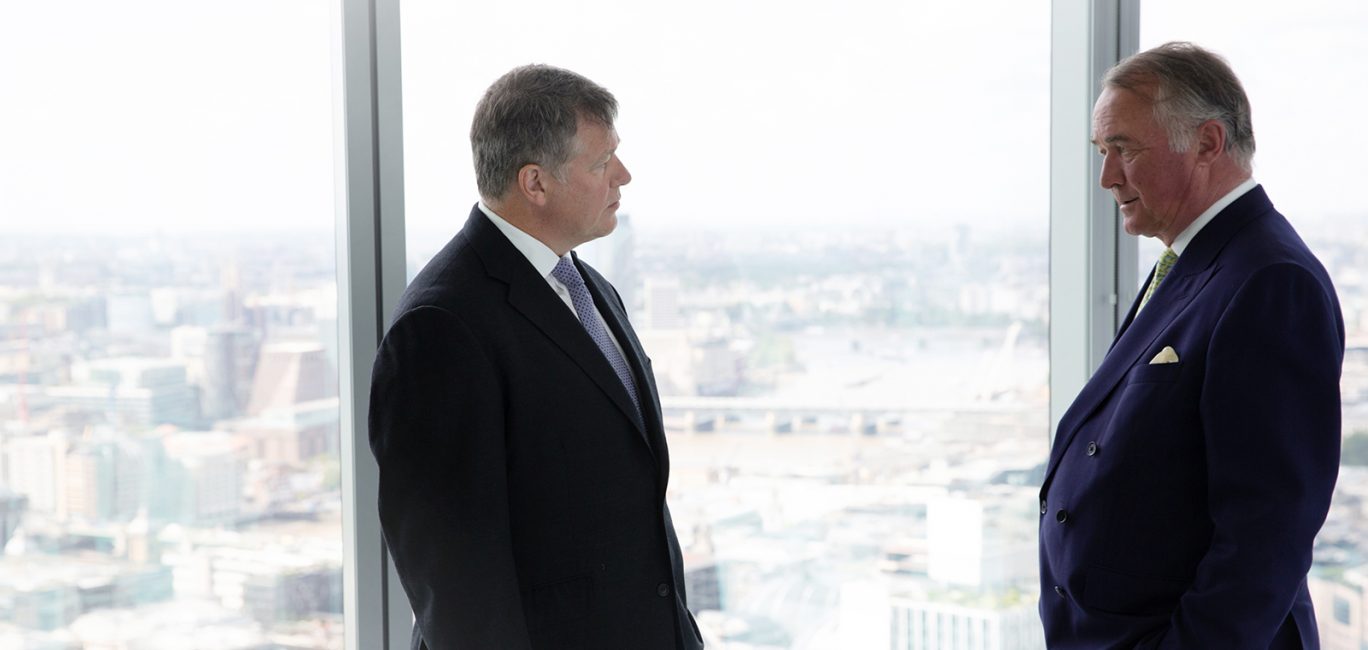Ready to Launch: Stephen Catlin and Paul Brand – The Reactions interview
Published September 25, 2019Reactions, Garry Booth
The return of Stephen Catlin and Paul Brand to the global re/insurance stage was one of the most highly anticipated events of the year. Since they revealed their plan to launch Convex Group, a “first of its kind” carrier that makes full use of new technology and outsourced services, the market has been agog.
Speaking with Garry Booth in their temporary WeWork office suite by Tower Bridge, co-founders Stephen Catlin and Paul Brand outline their plans for Convex and explain why it’s going to be different this time.
What’s been the market’s response to the launch of Convex?
Stephen Catlin: We have seen the full spectrum of responses, but in general people have been unbelievably supportive – even competitors. I couldn’t ask for a higher accolade. Clients are supportive, and distributors are supportive as well. But of course there is inevitably some background noise about, are we doing to underprice to get business in the front door?
Paul Brand: At this stage in the market cycle, there’s a big dispersion between best-in-class businesses and underperformers who are experiencing problems. It’s the latter segment that is most worried about us. But we are not prepared to put top line on. The market is better than it was, but it is still not great.
SC: The expressed values of the invested money and the fact that it is 10-year is a huge plus for Convex. We don’t have to panic about getting earnings onto the balance sheet on Day One. What we are concerned with now is building strong foundations for the future. By November, the underwriting leadership will be 90% in place.
How different is it for you this time, compared with 35 years ago when you started Catlin?
SC: It was so much easier doing it this time around than [with Catlin] last time. Paul and I have a track record, we have networks; we can afford to employ the resources we need immediately, which we couldn’t always do before. When Paul joined Catlin in 1987 he was just the eighth employee – that gives you an idea of how different it was then.
What’s your strategy for differentiating Convex in a competitive market?
SC: We characterise ourselves as a global specialty insurer and reinsurer, concentrating on complex, high-value risk. That’s another way of saying that we are not in the commodity market. It’s where Paul and I made our mark originally, in the reinsurance field and in the energy sector.
PB: If you look at the insurance world today, in addition to the transition from a softer to a harder market, there are clients who want more bespoke services. Then there are others who want simplification, transparency and speed. We intend Convex to be the market of choice for clients who care about who their carriers are; clients that care about why they are buying insurance.
A problem for many incumbents in the Property & Casualty business is that as well as clients who care, they have others that don’t, the commodity business. It’s a problem because the underwriters, systems and processes that are needed to address those different client profiles are very different. At Convex we have the advantage that we can target just one part of the market. It’s not cherry picking: it’s knowing what we’re good at and focusing on it.
SC: Everyone knows that Catlin was the largest Lloyd’s syndicate for about 12 years. What many don’t realise is that we used to lead on over half our business, far more than any other syndicate in the Room. We gained a reputation over 25 years for paying claims fairly and quickly, for acting thoughtfully and responding fast to changes in circumstances without exposing intermediaries or clients to nasty surprises. Having that track record has meant that placing broker and underwriters leading on businesses are actually more supportive of us than following capacity is.
How different is it for you this time, compared with 35 years ago when you started Catlin?
SC: It was so much easier doing it this time around than [with Catlin] last time. Paul and I have a track record, we have networks; we can afford to employ the resources we need immediately, which we couldn’t always do before. When Paul joined Catlin in 1987 he was just the eighth employee – that gives you an idea of how different it was then.
What’s your strategy for differentiating Convex in a competitive market?
SC: We characterise ourselves as a global specialty insurer and reinsurer, concentrating on complex, high-value risk. That’s another way of saying that we are not in the commodity market. It’s where Paul and I made our mark originally, in the reinsurance field and in the energy sector.
PB: If you look at the insurance world today, in addition to the transition from a softer to a harder market, there are clients who want more bespoke services. Then there are others who want simplification, transparency and speed. We intend Convex to be the market of choice for clients who care about who their carriers are; clients that care about why they are buying insurance.
A problem for many incumbents in the Property & Casualty business is that as well as clients who care, they have others that don’t, the commodity business. It’s a problem because the underwriters, systems and processes that are needed to address those different client profiles are very different. At Convex we have the advantage that we can target just one part of the market. It’s not cherry picking: it’s knowing what we’re good at and focusing on it.
SC: Everyone knows that Catlin was the largest Lloyd’s syndicate for about 12 years. What many don’t realise is that we used to lead on over half our business, far more than any other syndicate in the Room. We gained a reputation over 25 years for paying claims fairly and quickly, for acting thoughtfully and responding fast to changes in circumstances without exposing intermediaries or clients to nasty surprises. Having that track record has meant that placing broker and underwriters leading on businesses are actually more supportive of us than following capacity is.
Stephen, you are a past chairman for the Association of Bermuda Insurers and Reinsurers: was opting for Bermuda a less complicated choice?
SC: I spoke to the UK regulators, including Bank of England governor Mark Carney, and the Treasury about our plans before any firm decisions were made about Convex. The shared reaction was, “Great – UK plc is in need of god news.” The response from Bermuda was not dissimilar.
After losing a number of holding companies in the recent past due to consolidation, it is a positive political statement for Bermuda to say they now have an extra $2bn of new capital. So Convex is music to their ears in that sense.
The island’s regulators asked us some tough questions nonetheless, but we were prepared and could answer them on the spot every time. There were no shortcuts. But we do have a track record, and trust comes with that.
Relatively, the volume of business coming into London from Europe is small. But is Brexit still an issue?
SC: [Former international trade secretary] Liam Fox said to me that Brexit potentially fees the market from onerous regulation. But if we end up leaving Europe and are still subject to EU rules and regulations we have shot ourselves in the foot, he warned. It’s the worst of all worlds.
Liam Fox is right because EU regulation is costly, draconian and often ill-thought-out. It is a danger at a time when London’s financial services sector is thriving. It’s a prize we have to lose, not to win, as a country in my opinion.
It’s interesting that when [Catlin] did a capital raise in 2001 we spent half our time talking about Lloyd’s: we had to. This time we expected to be talking about Brexit [with investors] the whole time. Actually, very few investors asked about it – and no one suggested it is a potential deal-breaker.
PB: The U.S. markets are simply not overconcerned about Brexit. Also, we don’t yet have any EU clients. We don’t have to put anything into place to deal with what might or might not happen. We can wait for clarity and adjust our business to suit the new reality.
SC: A solution for Convex [to writing business in the EU] would be to passport through Lloyd’s Brussels, for example, or to have a company in an EU centre, like Dublin. Both increase cost, and Convex is not looking to add cost. So planning for an EU platform is also something we can “park”, if only because there is a lot more to play out yet with Brexit.
The Convex business model is predicated on outsourcing. But are there risks you had to address in outsourcing operations?
SC: I don’t have any doubts about the commercial pragmatism of outsourcing. But I was exercised quite early on, but the question of the potential downside of risk. I appreciated that the regulator might ask about it, and sure enough the PRA and FAC did bring it up with me.
I told our people that we must have a Plan B. Let’s not ask whether something could happen – you simply can’t say it will never happen. Make a plan and show it to me in writing.
To his credit, Adrian Spieler, our chief operating officer, came back with a very detailed plan on what contingency measures we need to have in place. So I think we now understand that not outsourcing services is not risk-free – but there are risks attached to not outsourcing as well, for a start-up.
Plus, the technology that our providers have in place would be unaffordable to a start-up. It’s true that if you outsource to one provider, all you eggs are in one basket. But on the other hand, you can communicate easily with your back office through technology.
We will retain operations that require human intervention, such as reserving, underwriting, pricing and claims adjustment (as opposed to claims process).
What’s behind the partnership with UK-based InsurTech Cytora to develop artificial intelligence-powered underwriting solutions for commercial insurance business?
PB: It’s our collaboration with Cytora – one of a number of innovative InsurTech companies – that makes London such a great place to be. Throughout Catlin’s history we invested consistently in improving our ability to make better decisions. Making investments like this with Cytora and building a decision-making advantage is also an imperative at Convex.
Our challenge is not how to make the best decisions but how to make better decisions; working out what we can do to give ourselves a decision-making advantage. From a personal point of view, I’ve always had an inner tech nerd, which helps!
Is the absence of “legacy” an advantage in today’s market?
SC: Because we are greenfield, we are baggage-free in terms of process as well as liability; we ca start with a blank sheet of people on everything. Coupled with experience, it gives us a tremendous in-build advantage.
I have every sympathy for people that don’t have that advantage, because you can build a substantial legacy business really quickly! For the big brokers and big carriers it becomes like piloting a super tanker with a dinghy rudder. It is very hard to do, especially when there is a crosswind.
Businesses with legacy processes face significant challenges that have grown exponentially. CEOs have known they need to address these problems but no-one, particularly if they are a public company, wants a hit on their quarterly earnings. They don’t want to be the first one to jump.
PB: It is very difficult for public companies to jump, if their results are under pressure – and the pressure is on the cut costs rather than invest.
SC: It is a massive4 advantage to us if we save 3% on expenses (which is 5% on ROE). We have got a blank sheet of paper to start thinking about how we analyse the business going forward, predicated on past experience in terms of knowledge and also future technology which is so much more capable.
We regard ourselves as being exceptionally fortunate to find ourselves in this position. A lot of people in their careers find that maybe the stars come into line just once in their lifetime. For Paul and I, in our careers together, it has happened twice and we intend to capitalise on this opportunity to maximum.
Please note that this interview was first published in Reactions September issue. https://www.reactionsnet.com/articles/3592715/reactions-september-digital-issue-online-now-





